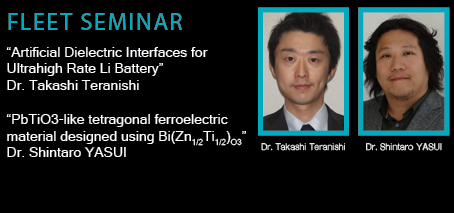-
25 Sep 2019
11:30 am - 12:30 pm
11:30-12:00 pm Talk
Artificial Dielectric Interfaces for Ultrahigh Rate Li Battery Dr Takashi Teranishi.
Graduate School of Natural Science and Technology, Okayama University, Japan
12:00-12:30 pm Talk
PbTiO3-like tetragonal ferroelectric material designed using Bi(Zn1/2Ti1/2)O3
Dr Shintaro Yasui.
All welcome! The seminar flyers can be downloaded by clicking on this link
Dr Takashi Teranishi
Abstract:
Artificial Dielectric Interfaces for Ultrahigh Rate Li Battery
Lithium ion batteries (LIBs) with drastically enhanced power densities enable shortening of charging time of electric vehicles and better fuel saving for hybrid vehicles. A breakthrough involving dielectric polarization to assist ultrahigh rate capability of the LIBs is proposed. It is related with the use in the batteries of dielectric nanoparticles having adequate dielectric constant as an artificial solid electrolyte interfaces, SEIs. The dielectric interfaces are synthesized via liquid phase reaction; simple sol–gel and metal organic decomposition (MOD) routes. In fact, high rate capability is drastically improved by incorporating barium titanate (BaTiO3) based ferroelectrics [1-3]. In particular at low temperatures, the correlation between the permittivity of the dielectric SEIs and the high-rate capabilities of the cells is striking [4]. A series of experimental results, e.g., electrochemical impedance spectroscopy (ECIS) [5], X-ray absorption fine structure (XAFS) [6], electric current density calculation and so on, imply the drastic enhancement of the high rate capability is attributed to polarization driven fast charge transfer at dielectrics-active materials-electrolyte triple phase junction.
[1] Appl. Phys. Lett., 105, 143904 (2014). [2] ECS Electrochem. Lett., 4, A137 (2015). [3] Solid State Ionics., 314, 57 (2018). [4] Adv. Electr. Mater., 4, 1700413 (2018). [5] Jpn. J. Appl. Phys., 54, 10NB02 (2015). [6] J. Ceram. Soc. Jpn., 124, 659 (2016).
BIO:
Takashi Teranishi was born in Ishikawa, Japan. He received B. Eng., M. Eng., and Ph. D. degrees in 2004, 2006, and 2010, respectively from Tokyo Institute of Technology. He worked at Fujifilm Co., Ltd. from 2007 to 2008. He has been working as an Assistant Professor in the Department of Applied Chemistry of Okayama University since 2010. He is currently an Associate Professor at Okayama University. His current research interests include ferroelectric materials, oxygen- and lithium-ion conductors, and solid-state-batteries.
Dr Shintaro Yasui
Abstract:
PbTiO3-like tetragonal ferroelectric material designed using Bi(Zn1/2Ti1/2)O3
For design of large piezoelectric property using morphotropic phase boundary (MPB), tetragonal ferroelectric materials are very important due to extrinsic piezoresponse such as domain switching. It is well known that Pb(Zr,Ti)O3, Pb(Mg1/3Nb2/3)O3-PbTiO3 and Pb(Zn1/3Nb2/3)O3-PbTiO3 systems having large piezoelectricity are used this concept, and included tetragonal PbTiO3 as an end member. To design novel piezoelectric materials, the discovery of alternative to PbTiO3 are key point. In the past, the investigation of tetragonal lead-free ferroelectric materials was limited only BaTiO3 and (Bi,K)TiO3 family. In 2006, Bi-based tetragonal ferroelectric materials of BiCoO3 and Bi(Zn1/2Ti1/2)O3 were synthesized by high pressure technique.[1,2] In this study, we focused on these tetragonal materials and prepared solid solution epitaxial thin films of rhombohedral BiFeO3 and tetragonal Bi(Zn1/2Ti1/2)O3 by metalorganic chemical vapor deposition(MOCVD).[3] Crystal structure, electrical and piezoelectric properties of films were investigated systematically.
[1] A. A. Belik, S. Iikubo, K. Kodama, N. Igawa, S. Shamoto, S. Niitaka, M. Azuma, Y. Shimakawa, M. Takano, F. Izumi, and E. Takayama-Muromachi, Chem. Mater. 18, 798 (2006).[2] M. R. Suchomel, A. M. Fogg, M. Allix, H. Niu, J. B. Claridge, M. J. Ro sseinsky, Chem. Mater. 18, 4987 (2006).
[3] S. Yasui et al., Appl. Phys. Lett. 103, 042904 (2013).
BIO:
Shintaro Yasui was born in Hiroshima, Japan. He received B.S. in department of chemistry, Sophia university, Japan. He received M.E. and Ph.D in department of innovative and engineered materials, Tokyo Institute of Technology, Japan in 2011. From 2011 to 2013, he was a postdoctoral researcher at the National Institute of Standards and Technology, and University of Maryland, USA. He is currently an Assistant Professor at the Tokyo Institute of Technology. His research interests include ferroelectrics, piezoelectrics, ionic conductors, and thin film growth.
Venue: G59-G60, Old Main Building K15
Address:

